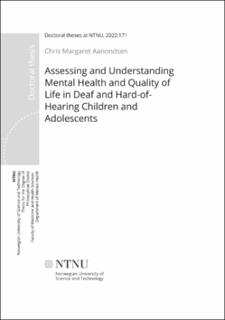| dc.contributor.advisor | Rimehaug, Tormod | |
| dc.contributor.advisor | Jozefiak, Thomas | |
| dc.contributor.advisor | Heiling, Kerstin | |
| dc.contributor.advisor | Gascon-Ramos, Maria | |
| dc.contributor.author | Aanondsen, Chris Margaret | |
| dc.date.accessioned | 2022-05-30T12:38:44Z | |
| dc.date.available | 2022-05-30T12:38:44Z | |
| dc.date.issued | 2022 | |
| dc.identifier.isbn | 978-82-326-6838-0 | |
| dc.identifier.issn | 2703-8084 | |
| dc.identifier.uri | https://hdl.handle.net/11250/2996863 | |
| dc.description.abstract | Mental health problems are more prevalent in deaf and hard-of-hearing - (D)HH - children and adolescents. Using written measures to assess mental health problems in (D)HH children and adolescents has been found to underestimate symptoms and prevalence. Misdiagnosis is also more common among (D)HH children and adolescents due to an overlap of cultural, linguistic and clinical factors. Therefore, validated measures in sign language are needed. Controversies still exist regarding Quality of Life (QoL) in (D)HH children and adolescents compared to typically hearing (TH) children and adolescents. Good communication skills in spoken and sign language are associated with better mental health in (D)HH children and adolescents. Technological advances, recognition of sign languages as natural languages, universal neonatal hearing screening and early intervention programs have been introduced, affecting language outcomes. These changes are also likely to have impacted mental health and QoL outcomes.
To improve assessment and interventions for (D)HH children and adolescents, this thesis aimed to translate reliable and valid questionnaires for mental health and QoL into Norwegian Sign Language (NSL) and validate these. The second aim of the study was to gain a better understanding of signing DHH and hard-of-hearing (HH) children and adolescents’ mental health, QoL and communication as well as associations between these aspects. To do so, the Strengths and Difficulties Questionnaire (SDQ) and the Inventory of Life Quality in Children and Adolescents (ILC) were translated into NSL. Then, 107 (D)HH children and adolescents, 60 DHH and 47 HH, and their parents completed the self- and parent-reports of the SDQ and ILC. DHH children and adolescents completed both the written and NSL versions in randomised order, while the HH children and adolescents completed the written versions only. Parents also provided information about their children’s spoken and sign language skills, communicative competence, hearing loss (HL), and school. Data were collected between 2016 and 2018.
The SDQ-NSL and the ILC-NSL showed acceptable reliability and construct validity. Their psychometric properties were also found to be similar to the original validations. The lack of associations between the two language versions of the child ILC, however, requires further attention. The prevalence of self-reported mental health problems in the clinical range was about twice as high for DHH and HH children as their TH peers. The SDQ-NSL seemed to differentiate better between mental health problems in the normal, borderline and clinical range for DHH children and adolescents than the SDQ-NOR. Self-reported QoL of (D)HH children and adolescents, on the other hand, was found to be similar to that of TH children and adolescents. Associations between communicative competence and parent-reported mental health and QoL were significant, whereas severity of hearing loss (HL) was not associated with either QoL or mental health.
In conclusion, the SDQ-NSL and ILC-NSL are reliable and valid measures to assess mental health and QoL in signing DHH children and adolescents. The elevated prevalence of mental health problems in (D)HH children and adolescents emphasises the importance of early detection of HL, early intervention and regular monitoring of socio-emotional, cognitive and language development, mental health and QoL. The risk of misdiagnosis combined with the elevated prevalence also confirms the need for robust and accessible specialised CAMHS for (D)HH children and adolescents. Furthermore, validated measures for assessment of pragmatic skills and social communication in NSL are needed to improve assessment of co-morbid language disorders and future research. | en_US |
| dc.language.iso | eng | en_US |
| dc.publisher | NTNU | en_US |
| dc.relation.ispartofseries | Doctoral theses at NTNU;2022:171 | |
| dc.relation.haspart | Paper 1: Aanondsen, Chris Margaret; Jozefiak, Thomas; Heiling, Kerstin; Rimehaug, Tormod. Validation of the Strengths and Difficulties Self-Report in Norwegian Sign Language. Journal of Deaf Studies and Deaf Education 2019 ;Volum 25.(1) s. 91-104 https://doi.org/10.1093/deafed/enz026 | en_US |
| dc.relation.haspart | Paper 2: Aanondsen, Chris Margaret; Jozefiak, Thomas; Heiling, Kerstin; Lydersen, Stian; Rimehaug, Tormod. Psychometric properties of the Inventory of Life Quality in children and adolescents in Norwegian Sign Language. BMC Psychology 2021 ;Volum 9.(1) s. 1-14 https://doi.org/10.1186/s40359-021-00590-x This article is licensed under a Creative Commons Attribution 4.0 International License (CC BY 4.0) | en_US |
| dc.relation.haspart | Paper 3: Aanondsen, C. M., Jozefiak, T., Heiling, K., Lydersen, S., Rimehaug, T. (2022). Deaf and hard-of-hearing children and adolescents' mental health, Quality of Life and communication. | en_US |
| dc.title | Assessing and Understanding Mental Health and Quality of Life in Deaf and Hard-of-Hearing Children and Adolescents | en_US |
| dc.type | Doctoral thesis | en_US |
| dc.subject.nsi | VDP::Medical disciplines: 700 | en_US |

